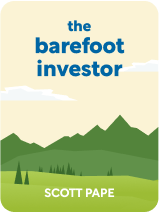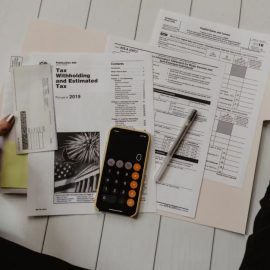

This article is an excerpt from the Shortform book guide to "The Barefoot Investor" by Scott Pape. Shortform has the world's best summaries and analyses of books you should be reading.
Like this article? Sign up for a free trial here .
What do you want your financial future to look like? What can you do to secure your financial future and ensure yourself a comfortable retirement?
Being financially secure in retirement may be the last thing on your mind if you are in your 30s or 40s. But if you want to retire comfortably, it is important to start thinking of ways to secure your financial future many years in advance.
Here are three ways you can secure your financial future so you can enjoy a comfortable retirement.
Secure Your Financial Future
The cost of living keeps rising due to inflation, so you’ll need more money to cover the cost of basic expenses in the future. For example, a loaf of bread will cost more when you’re 90 than it does now. With this in mind, it is important to think ahead and plan for the future many years in advance. To secure your financial future and ensure yourself comfortable retirement, consider the following three strategies:
1) Increase Your Super Contribution
One of the simplest, surest, and most risk-free ways to secure your financial future is to increase your super contribution. In Australia, the government mandates saving for retirement by requiring Australian employers to divert 9.5 percent of each employee’s pay toward their super fund—but this isn’t sufficient for employees to retire on. The average Australian runs out of retirement savings 13 years before they die.
In Australia, call your super to direct more of your income there. Choose one of these approaches, depending on your income situation:
- If you earn more than $52,697, call your super and arrange to pay additional pre-tax money. If you’re under 75 years of age, you can claim a tax deduction for contributing additional funds to your super.
- If you earn less than $52,697, call your super and ask to contribute some of your after-tax money. The Australian government will pay 50 cents for every after-tax dollar you invest in your super. For example, if you invest $1,000, the government will contribute $500.
- If you’re self-employed, call your super and arrange to pay 15 percent of your pre-tax dollars. As a self-employed Australian, you’re not required to pay yourself super at all, but since you need a retirement plan and it’s one of the best retirement investments out there, it’s a good idea to do it.
(Shortform note: In U.S. employer-sponsored plans, you can often set or adjust your contribution rate by logging in to the plan’s website. Some employers will match your contribution up to a certain amount.)
2) Invest in Shares
Investing in shares (stocks) is one of the simplest ways to let your money grow for you with little management. The stock market and superannuations (retirement plans) use compound interest—when your investments earn interest that you then reinvest—to grow your wealth. Some funds will automatically reinvest your dividends, or the twice-yearly payments your fund makes.
One of the hardest parts of investing is starting, but it’s worth it in the long run due to compound interest. The sooner you start, the more you’ll earn, as this chart based on an 8 percent annual return shows.
| Invest → | $0/month | $100/month | $500/month | $1,000/month |
| In 5 years, you’ll have: | 0 | $7,040 | $35,200 | $70,399 |
| In 10 years, you’ll have: | 0 | $17,384 | $86,919 | $173,839 |
| In 25 years, you’ll have: | 0 | $87,727 | $438,636 | $877,271 |
Australians have two options to invest in shares:
- Invest within super. Consider a fund that allows you to choose the shares you invest in without having to pay much in maintenance costs. Along with his HostPlus super, Pape uses a ChoicePlus fund that allows him to invest in shares of Australia’s 300 biggest companies. You need $10,000 to start and must have $2,000 in another HostPlus account. The maintenance fees cost $180 per year.
- Invest outside of super. You’ll have to use after-tax money. Though investing in shares through super offers a better option from a tax perspective, investing outside of it makes sense if:
- You want access to the money before you retire.
- You want to invest in companies that you can’t invest in through super, such as smaller companies
(Shortform note: Apply this advice to your 401(k) or other retirement accounts. If you opt into your employer’s retirement program and you invest in it, you’ll use pre-tax dollars. If you invest in an outside account, you’ll use after-tax money.)
Growing Wealth: April Mac’s Story
April Mac wasn’t in debt, but she didn’t have much money either—she consistently spent all of her money and didn’t think she and her husband could build long-term wealth. After her sister encouraged her to sign up for Pape’s online resources, she made and met a number of financial goals:
Saved $16,000 in shares
Paid $30,000 off their mortgage and saved another $30,000 for home improvements
Saved money for emergencies into her Backstop account
Took her family on several vacations
Mac thinks she isn’t special and hopes her story inspires other ordinary people to get their finances in order.
3) Invest in Your Children and Grandchildren’s Future
Many Australian parents struggle to pay for their children’s educational expenses. Saving for children’s education can help them pay for school, invest in homes of their own, and more.
There are two main options for investing for your children or grandchildren:
- Invest in your name. If you’re Australian and your partner earns less than $37,001 annually, buy shares that have low management costs through your bank. Since you own the shares, you’ll pay taxes, but only on any earnings over $18,200. You’d have to invest $300,000 before paying taxes.
- Invest in bonds. Investment bonds are a type of share fund. There are three main benefits to investing in bonds:
- You won’t pay capital gains if you sell after the bond is 10 years old.
- Taxes are paid within the bond, so you don’t pay them.
- Each year, you can increase your contribution 25 percent.

———End of Preview———
Like what you just read? Read the rest of the world's best book summary and analysis of Scott Pape's "The Barefoot Investor" at Shortform .
Here's what you'll find in our full The Barefoot Investor summary :
- A 10-step plan to eliminate debt and build wealth
- How you can increase your income
- Why you need to focus on cultivating long-term investments






